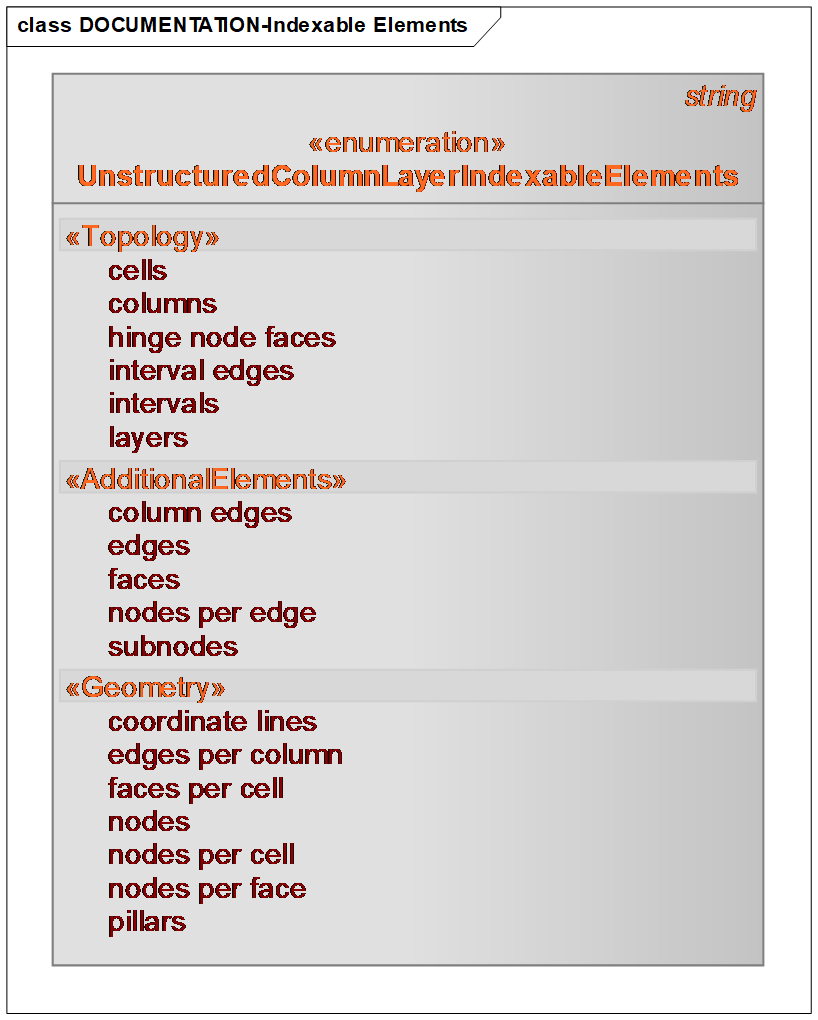11.13.3 Unstructured Column-Layer Grid Indexable Elements
| Topic Version | 1 | Published | 09/11/2015 | |
| For Standard | RESQML v2.0.1 | |||
The unstructured column-layer grids have both implicit and explicit topological relationships between the grid elements and a corresponding mixture of implicit and explicit indexing. As shown in Figure 11.13.3-1 , the indexable elements can be organized into three categories: topology, geometry, or additional elements.

|
Element |
Definition/Description of Use |
|---|---|
|
Topology |
Those elements whose indexing only depends upon the grid indices, which in this case are the ColumnCount and NK. Element indexing is described using the following indices:
For the unstructured column-layer grid representation, the GapCount=0 and the interval and layer indexing are identical. However, when this topology is re-used as part of a general purpose grid, gaps are supported and these two indices need not be identical. |
|
Geometry |
Those elements that need to be introduced to support the description of the geometry of the grid, which in this case are the nodes on the coordinate lines of the grid. The pillar count is explicit, and the CoordinateLineCount = PillarCount + SplitCoordinateLineCount. Both are 1D indices. The nodes always have a 2D index constructed from the number of coordinate lines with NKL nodes per coordinate line. Faces per cell, nodes per cell and nodes per face are indexed in an implicit fashion, which is in contrast to the unstructured grid, where indexing is explicit. By RESQML convention, for all of these elements, the ɣ=0 face or nodes are indexed first, followed by the ɣ=1 face or nodes. The areal ordering of the elements follows from the explicit definition of columns in terms of pillars. |
|
Additional Elements |
Faces are the most commonly used, and their definition requires the specification of the column edges. Neither are required for the specification of the column-layer grid cell. They may be required for either property indexing or for higher order finite element geometries. The face count is a one dimensional index constructed from an ordered combination of the column edges, the columns, NK and NKL: FaceCount = ColumnCount x NKL + ColumnEdgeCount x NK, in this order. Faces should not be confused with faces per cell. If a face is shared between two cells, then it appears only once as an enumerated face, but twice as an enumerated face per cell. |
As with IJK grids, there are a number of “object1 per object2” indexable element kinds for unstructured column-layer grids, which may be used in favor of “object1” indices when the latter are more complicated. For example, for an unstructured column-layer grid, for a column of the model with N sides, there are N+2 “faces per cell”: 0=top, 1=bottom, 2-(N+1) are side faces following the explicit pillars per column ordering. This is a very simple enumeration, versus the “faces” indexing, which depends on the grid faulting and column edge enumeration. Faces per cell indices appear in the grid connections representation and the blocked wellbore representation.